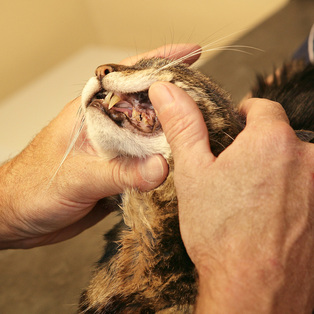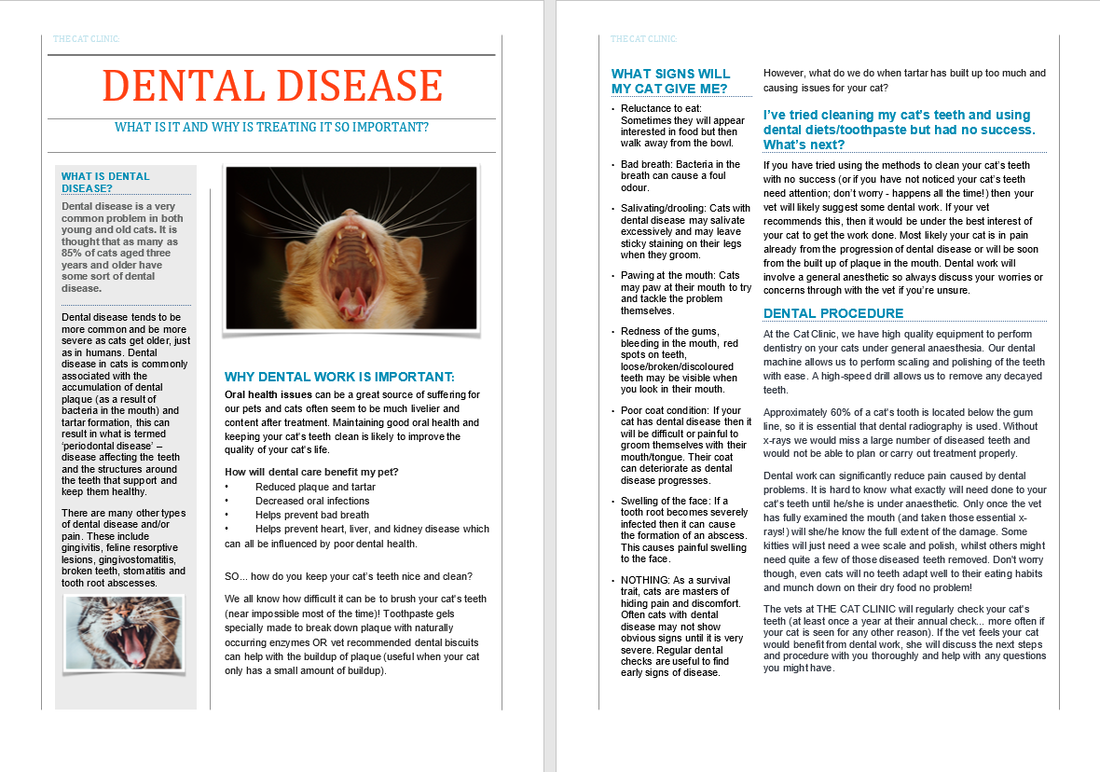Dental Care
 Examining a patient's teeth
Examining a patient's teeth
Healthy Teeth
Kittens have 26 temporary teeth. These are gradually lost at around 4-6months of age as the adult teeth erupt. Adult cats have 30 teeth.
They are similar in composition to human teeth having an outer hard enamel layer covering the dentine which forms the bulk of the tooth. Inside the tooth is the pulp cavity which carries the blood vessels and nerves which keep the tooth alive.
A large portion of the tooth is the root which is situated within the jawbone and attached with periodontal ligament and cementum. The gums or ‘gingiva’ cover the jawbone.
The cat uses its teeth for hunting and grabbing food. They are a part of their armour for defending themselves against other cats and animals. They are also involved in grooming.
Dental disease
The first stage of dental disease is the formation of PLAQUE which is a soft film of saliva, debris, and bacteria which thrive and multiply in this environment. As the plaque spreads into the area between the tooth and gum, the bacteria produce toxins which cause inflammation or GINGIVITIS. This begins as a reddened ring around the edge of the tooth but becomes more inflamed and swollen. The attachments between the tooth and gum become damaged. Minerals from the saliva gradually crystallise into the plaque to form a hard material called CALCULUS or TARTAR. (The rate at which this develops varies between cats). As gingivitis progresses, some of the damage becomes irreversible. The supporting structures of the tooth become damaged and lost. The bone socket is eaten away. Tooth roots become exposed, loosen and in time are lost.
Cats are also vulnerable to erosions in the tooth enamel called FELINE ODONTOCLASTIC RESORPTIVE LESIONS or ‘FORLs’. These can be very painful. The disease process is not yet fully understood and tooth extraction is the best course of action.
STOMATITIS is another condition that some cats suffer from. This process also is not widely understood but there may be a link to certain viruses. These cats tend to have healthy teeth but the gums and other parts of the mouth develop severe and painful inflammation.
Signs of dental disease
· Reluctance to eat: Sometimes a cat with dental disease will appear interested in food but will then walk away from the bowl.
· Bad breath: Bacteria in the mouth can cause a foul odour
· Salivating/drooling: Cats with oral problems may salivate excessively and may leave sticky staining on their legs when they try to groom.
· Pawing at the mouth: Cats with severe pain/discomfort in their mouth may ‘paw’ at their mouth to try to tackle the problem themselves.
· Redness of the gums, bleeding in the mouth, red spots on the teeth, loose/broken/discoloured teeth may be visible when you look in their mouth.
· Poor coat condition: Cats groom using their mouth and tongue. If they have dental disease then this will be painful or difficult for them. Their coat condition can deteriorate as dental disease progresses.
· Swelling of the face: Sometimes if a tooth root becomes severely infected it can cause the formation of an abscess. This causes a painful swelling on their face.
· Nothing!: As a survival trait, cats are masters of hiding pain and discomfort. Often cats with dental disease may not show obvious signs until it is very severe. Regular dental checks are useful to find early signs of disease.
What can you do?
· Dental diets. These are complete diets where the kibble has been formulated in size and texture to have a gentle abrasive effect on plaque and tartar. Other ingredients may slow down tartar build up and inhibit bacteria to reduce bad breath.
· The gold standard for plaque removal is the daily use of a toothbrush with cat-friendly toothpaste. This is not always an easy task with cats but if trained with a ‘softly-softly’ approach it can be a successful means of dental care. Kittens are usually more adaptable than adult cats
· Enzymatic toothpastes. These can be administered daily with no brushing required. The active ingredients break up plaque and help prevent the formation of new plaque but aren’t as effective as brushing.
· Be observant and don’t delay. Keep an eye on your cat’s behaviour and condition. If you notice any signs of dental disease then seek help. The sooner problems are detected, the easier they tend to be to remedy.
· Regular check ups can detect early signs of dental disease allowing the vet to make recommendations for how to treat or slow down progression of dental disease. The oral exam can also detect problems associated with other disease processes eg: cat flu and renal disease can cause mouth ulcers. Jaundice from liver disease can show up as yellow gums. Growths/tumours can grow in the mouth and cause similar symptoms to dental disease.
Poor dental health also has an impact on the whole body. Bacteria from the mouth can easily enter the blood stream via inflamed gums. Healthy animals can usually cope with this but cats with underlying health problems can develop infections and damage to other organs eg. Kidney, heart, lungs, liver, and pancreas.
Kittens have 26 temporary teeth. These are gradually lost at around 4-6months of age as the adult teeth erupt. Adult cats have 30 teeth.
They are similar in composition to human teeth having an outer hard enamel layer covering the dentine which forms the bulk of the tooth. Inside the tooth is the pulp cavity which carries the blood vessels and nerves which keep the tooth alive.
A large portion of the tooth is the root which is situated within the jawbone and attached with periodontal ligament and cementum. The gums or ‘gingiva’ cover the jawbone.
The cat uses its teeth for hunting and grabbing food. They are a part of their armour for defending themselves against other cats and animals. They are also involved in grooming.
Dental disease
The first stage of dental disease is the formation of PLAQUE which is a soft film of saliva, debris, and bacteria which thrive and multiply in this environment. As the plaque spreads into the area between the tooth and gum, the bacteria produce toxins which cause inflammation or GINGIVITIS. This begins as a reddened ring around the edge of the tooth but becomes more inflamed and swollen. The attachments between the tooth and gum become damaged. Minerals from the saliva gradually crystallise into the plaque to form a hard material called CALCULUS or TARTAR. (The rate at which this develops varies between cats). As gingivitis progresses, some of the damage becomes irreversible. The supporting structures of the tooth become damaged and lost. The bone socket is eaten away. Tooth roots become exposed, loosen and in time are lost.
Cats are also vulnerable to erosions in the tooth enamel called FELINE ODONTOCLASTIC RESORPTIVE LESIONS or ‘FORLs’. These can be very painful. The disease process is not yet fully understood and tooth extraction is the best course of action.
STOMATITIS is another condition that some cats suffer from. This process also is not widely understood but there may be a link to certain viruses. These cats tend to have healthy teeth but the gums and other parts of the mouth develop severe and painful inflammation.
Signs of dental disease
· Reluctance to eat: Sometimes a cat with dental disease will appear interested in food but will then walk away from the bowl.
· Bad breath: Bacteria in the mouth can cause a foul odour
· Salivating/drooling: Cats with oral problems may salivate excessively and may leave sticky staining on their legs when they try to groom.
· Pawing at the mouth: Cats with severe pain/discomfort in their mouth may ‘paw’ at their mouth to try to tackle the problem themselves.
· Redness of the gums, bleeding in the mouth, red spots on the teeth, loose/broken/discoloured teeth may be visible when you look in their mouth.
· Poor coat condition: Cats groom using their mouth and tongue. If they have dental disease then this will be painful or difficult for them. Their coat condition can deteriorate as dental disease progresses.
· Swelling of the face: Sometimes if a tooth root becomes severely infected it can cause the formation of an abscess. This causes a painful swelling on their face.
· Nothing!: As a survival trait, cats are masters of hiding pain and discomfort. Often cats with dental disease may not show obvious signs until it is very severe. Regular dental checks are useful to find early signs of disease.
What can you do?
· Dental diets. These are complete diets where the kibble has been formulated in size and texture to have a gentle abrasive effect on plaque and tartar. Other ingredients may slow down tartar build up and inhibit bacteria to reduce bad breath.
· The gold standard for plaque removal is the daily use of a toothbrush with cat-friendly toothpaste. This is not always an easy task with cats but if trained with a ‘softly-softly’ approach it can be a successful means of dental care. Kittens are usually more adaptable than adult cats
· Enzymatic toothpastes. These can be administered daily with no brushing required. The active ingredients break up plaque and help prevent the formation of new plaque but aren’t as effective as brushing.
· Be observant and don’t delay. Keep an eye on your cat’s behaviour and condition. If you notice any signs of dental disease then seek help. The sooner problems are detected, the easier they tend to be to remedy.
· Regular check ups can detect early signs of dental disease allowing the vet to make recommendations for how to treat or slow down progression of dental disease. The oral exam can also detect problems associated with other disease processes eg: cat flu and renal disease can cause mouth ulcers. Jaundice from liver disease can show up as yellow gums. Growths/tumours can grow in the mouth and cause similar symptoms to dental disease.
Poor dental health also has an impact on the whole body. Bacteria from the mouth can easily enter the blood stream via inflamed gums. Healthy animals can usually cope with this but cats with underlying health problems can develop infections and damage to other organs eg. Kidney, heart, lungs, liver, and pancreas.
